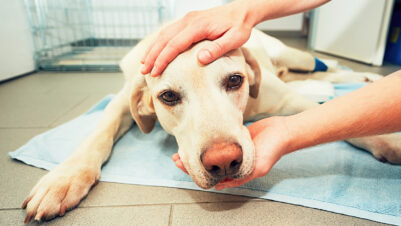I HAVE found a new way of dealing with unexpected stressful occurrences. It’s a dependable mixture of denial and pragmatism.
It works like this. Phase one: as soon as someone tells you the bad news you instantly make a quantum leap into the planning phase for the solution. Don’t even think about the bad news; it’s in the past, gone. Like an advertising hoarding on the side of a lorry that drives past you on a fast road, it comes up without warning, you’ve read it and it’s passed and past in an instant.
In the past, nothing you can do about it: in a word, gone. Almost like one of the semi-subliminal messages flashed up during a Monty Python episode. The key thing now is to proceed to stage two before your mind even has time to engage and think about the bad news.
Stage two is planning, finding solutions. The image I have for this is of Ralph Fiennes in a scene from the lm The Hurt Locker (we look very similar so it’s a natural association for me to make).
In this scene he is stranded in the desert of Afghanistan in enemy territory. His 4×4 is broken and instead of panicking he is marching around sounding con dent and shouting “Solutions, solutions anyone?” He is not worrying about the bad situation he is in, or having a meltdown, he is just looking for the solution.
Of course, where this analogy falls down, and possibly my whole scheme, is that shortly after this he is sadly shot in the head. However, my scheme has saved me and his character in this film from a nervous breakdown, albeit in his case it would have been a very short-lived one.
It has been one of those periods at the practice where we have had a few ups and downs and I have developed the coping strategy described above. As usual, these episodes involve staffing issues with some sad and unexpected goodbyes but, after initially taking the above steps to avoid panic, we have managed to recruit some really good people in their place.
One such loss was our long-standing receptionist who said she liked working with us but after eight years of facing the general public needed a break from them. As light relief from the public, she has taken a job in a secure mental health unit, or at least she’s telling us she’s working there.
Recruitment has been quite a topic of discussion in the profession this year and will be one of the challenges it faces in the years to come. I have just been looking through the excellent “Survey of the Profession” carried out by the Institute of Employment Studies on behalf of the RCVS (and which can be found in the “publications” section of the RCVS website).
There have been some recent news stories of practices having problems finding vets. One London practice owner reported that he had not had a single applicant. A rural practice owner also reported struggling to recruit and suspected that out-of-hours was a major off-putting factor.
Perception of out-of-hours as ‘dramatic and difficult’
An interesting point was made that due to emergency medicine and surgery being an emerging and an exciting discipline in the UK and much CPD being aimed that way, for example the excellent Vets Now congress, it is leading to a perception that all out-of- hours calls are dramatic and difficult.
Those of us who do our own out-of-hours can reassure any vets considering doing this work for the first time that the majority of it is pretty routine and often an “emergency” because the owner has sat and watched the dog cough or cat limp since coming home from work and decided that he or she can’t go to bed without having it looked at by the vet. Or the chronic old dog or cat that just can’t go through another night.
My recent favourite, and career first, was to visit a 19-year-old cat who was on holiday in a motorhome (with its owners, it couldn’t drive – it’s not that good an anecdote) and whose time had sadly come. At 11pm. On holiday. After 19 years.
In the profession as a whole, 56% of vets in small animal practice do their own out-of-hours (down a smidge from 60% in 2010). So for those of us recruiting into a practice that does its own out-of-hours, and for those recent graduates looking for work, over half of small animal vets need to expect to do out-of-hours.
Whilst never doing out-of-hours is now a valid career choice, it won’t be one that can employ all our graduates.
The factors affecting employment are also interesting to look at: 65% of vets responding to the survey work full-time with 19% of respondents currently working part-time – compared with 16% in 2010, 14% in 2006, 12% in 2002 and 11% in 2000.
The figure for male part-time working has more than doubled since 2006 and now 11% of them work part time. Female vets are still more likely to be part-time workers.
The male to female ratio of vets is increasing with 57% of practising vets now being female. Factor in that 76% of graduates since 2013 are female and 86% of retirees are male, then the feminisation of the veterinary profession will not only proceed but accelerate.
Part-time work is opening up more jobs for more people, but not necessarily more hours of work. With increasing percentages of female vets in the profession and the male vets increasingly going part-time, the “job share” will become far more common and will soak up some of the huge increase in graduate numbers we keep hearing about, 18% of whom at the time of the survey were yet to find a job.
So part-time work may lead to more job adverts, but possibly no more working vet hours and pay.
Non-UK nationals
Another negative employment factor for UK vet graduates is that a massive 19% of respondents to the survey were non-UK nationals. If that figure bears out across the nation, then nearly a fifth of vets working in the UK are not from the UK.
At a recent CPD event I attended that figure would certainly seem true, and judging by my own experience advertising for vets it would also ring true. Many employers are commenting that UK graduates are reluctant to do out-of-hours work whereas non- UK nationals accept it as part of being a vet.
The RCVS survey doesn’t have those exact figures but I will contact them to see if they can be drawn from the raw data of the survey: i.e. the percentage of vets in the UK doing their own out-of-hours who are non-UK graduates.
Our practice is, then, surprisingly typical. For a four-vet FTE practice we will be employing five vets, three female and two male. Three of the vets work part-time and one of those part-timers is male. One has dual nationality and one is non-UK.
We do our own out-of-hours to cover the work of four FTE vets (the UK average is just over five FTE vets’ work per one OOH vet).
We have also moved on according to trends. When I joined in 2003, the practice had three full-time male vets.
So for the future there will be more part-time workers and many more female vets. The percentage of male vets going part-time is rising strongly too. Small animal vets will continue to have to do OOH work and if UK graduates don’t want to do it then vets from the EU will happily do it for them.
Increased part-time work and global competition for jobs usually have a downward effect on salaries. For practice owners and employees that makes for an interesting and competitive future!










